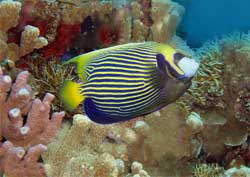Tubbataha Reef
 Why the
Tubbataha Reef
is special
Why the
Tubbataha Reef
is specialThe Tubbataha (too-bah-tah-hah') Reef in the remote center of the Sulu Sea is one of the world's finest dive locations. It has a rich and dense marine life – with several hundred species of both coral and fishes.
Tubbataha Reef tips & insights
Diver's paradise
Tubbataha Reef is noted among divers for its abundance of vivid corals, expansive sea ferns, colorful crustaceans, magnificent turtles, chromatic small fishes, and striking large fishes. The last includes sharks, whale sharks, mantas, tuna, and barracudas. And the soaring, perpendicular underwater walls are legendary.
Limited access
Tubbataha Reef is normally accessible only three months a year, from about mid-March to mid-June. Sea conditions are too rough for the remaining 9-month span.
Best months
For the best underwater visibility and the calmest seas, go in April or May.
Getting there
You can reach Tubbataha Reef only by boat. It lies 180 kilometers (110 miles) southeast of Puerto Princesa, the capital of Palawan. The voyage lasts about 10 hours each way.
Dive boats
You take a live-aboard dive boat. Usually, the tour is 5 nights and 6 days. You normally need to book months, if not years ahead. Dive boats and berths are limited and demand is high.
The site
-
Tubbataha Reef consists of two small, flat, sandy, modest-sized lagooned atolls. Most of the land is submerged at high tide.
- These atolls have no harbors or docks – and anchoring is forbidden (to protect the reef). All boats must use designated moorings away from the shore.
- Swells and winds sometimes disturbingly rock smaller live-aboards – so it's wise to book one of the larger, broader-beamed vessels.
Prior to 1988 when Tubbataha Reef became a government-protected marine park, the corals were severely scarred by dynamite, cyanide and other destructive fishing techniques. Today, this underwater wonderland has nearly recovered to its former glory.


